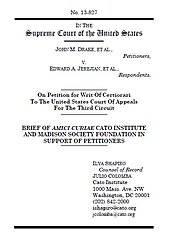Drake v. Jerejian
Learn more about Cato’s Amicus Briefs Program.
From the 1939 case of United States v. Miller until 2008’s District of Columbia v. Heller, the Supreme Court left unclear what right the Second Amendment protects. For nearly 70 years, the lower courts were forced to make do with Miller’s vague guidance, which in many jurisdictions resulted in a cramped and limited right to keep and bear arms, erroneously restricted to militia service. While Heller did eventually clarify that the Second Amendment secures an individual right to keep and bear arms for self-defense, the ruling left many questions about the scope of that right unanswered (and 2010’s McDonald v. City of Chicago merely extended the right to people living in the states, without further defining it). Since then, several courts have made clear that they plan to take only as much from Heller as they explicitly have to. One of these is the U.S. Court of Appeals for the Third Circuit, which last year upheld New Jersey’s “may-issue” handgun law, which says that an individual may be granted a carry license—read: may be permitted to exercise her Second Amendment rights—only if she proves an urgent need to do so to the satisfaction of a law enforcement officer. In order to prove this need, one must prove, with documentation, that there are specific, immediate threats to one’s safety that cannot be avoided in any way other than through possession of a handgun. If an individual can actually persuade the local official—who has total discretion to accept or deny the claim—then she gets a license for two years, at which time the gun owner must repeat the entire discretionary process (proving an imminent threat, etc.) to renew the permit. The effect of this regulatory regime is that virtually nobody in New Jersey can use a handgun to defend themselves outside their home. The state law inverts how fundamental rights are supposed to work—that the government must justify restrictions, not the right-holder the exercise—and the Third Circuit saw no problem with that. The court applied a deferential review far from the heightened scrutiny normally due an individual right enshrined in the Bill of Rights. It also assumed the legislature’s good faith without requiring the state to show any evidence that a restrictive-carry regime lowers the rate of gun crime, and excused what constitutional infringements the law may cause because legislators acted before Heller clarified that the Second Amendment protected an individual right. The Third Circuit’s opinion makes clear that it, like some other lower courts, is “willfully confused” about the scope of the right to keep and bear arms as recognized in Heller and the proper judicial methodology to apply when evaluating Second Amendment cases. We think it’s time that circuit and state courts got some guidance from the Supreme Court, so we filed a brief, joined by the Madison Society Foundation, supporting the challengers’ petition for review. This is an excellent case for the Court to take up to begin clarifying many of the unanswered questions involving the Second Amendment—such as to what extent it extends beyond the home and whether it can be conditioned on a showing of need. The Court has been hesitant to flesh out the contours of the Second Amendment. This hesitance has caused errant rulings that leave the right to bear arms hollow. Unless the Court intends the Second Amendment to lapse back into the second-class status it had before Heller, it needs to set the wayward courts straight.

This work is licensed under a Creative Commons Attribution-NonCommercial-ShareAlike 4.0 International License.
